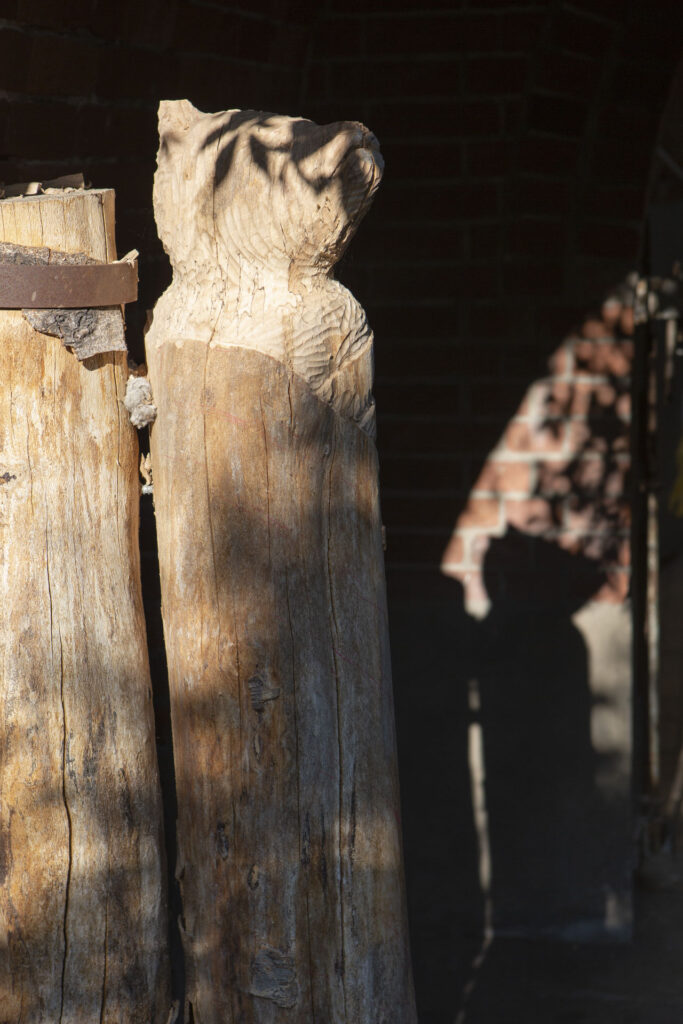1937
Until that day in autumn 2015, on which Schnute, the last female city-bear was euthanized, several generations of brown bears – Berlin’s heraldic animals – had inhabited the Bärenzwinger [bear pit] for almost eighty years.
The Bärenzwinger was officially opened on the 17th of August 1939 with the four bears Urs, Vreni, Lotte and Jule. Urs and Vreni came from the world-famous bear bit of Bern and were gifts from the city of Bern on the occasion of the 700th anniversary of Berlin in 1937.
Originally built for the city’s sanitation department in Köllnischer Park, the Berlin architect Georg Lorenz converted it into the Bärenzwinger.
Bound to an almost eighty-year history of the city, the Bärenzwinger was facing closure twice. All the bears except for Lotte were killed during the 2nd World War and the Bärenzwinger itself was buried under rubble. Thanks to the intervention of citizens, the area was cleared of rubble and reopened on the 29th of November 1949 with the bears Nante and Jette.
The preservation of the bear pit, located in the former East of the city, became a matter for debate shortly after the fall of the Wall due to its poor structural condition, until private donation initiatives finally set its restoration in motion.
Around the turn of the millennium, the keeping of the bears on the site encountered increasing opposition once again, this time because of doubts concerning the welfare of the animals. Criticism from animal welfare groups finally led to the municipal decision to discontinue the site’s usage as a bear pit after the death of Schnute.
2017
The cultural use of the Bärenzwinger as a location for exhibitions and events, lectures and discussions has been made possible through the transfer of the property to the Department for Further Education and Culture of Berlin-Mitte and the provision of support through interdisciplinary funding. Artists and scientists will be able to develop exhibition ideas on-site and progressively present them by way of carefully considered site-specific interventions and installations.
The cultural program of the former bear pit is organized by young curators of the Department of Arts and Culture, to whom the Bärenzwinger will be made available as a place of practice and learning during their traineeship.
After having stood empty for almost two years, the Department for Further Education and Culture has assumed responsibility for a cultural monument, which was home to Berlin’s heraldic animals for more than 80 years and thus has developed a high degree of popularity and sympathy among the citizens of Berlin.
Its immense effect on creating identity among Berliners is therefore of great value, both for the future urban planning around the area of the northern “Luisenstadt” as well as for the nearby historical center of Berlin.
The aim is to develop the location as a public place of cultural learning and teaching as well as a knowledge base for urban culture. In addition, exhibitions, workshops and events will reference cultural urban design, the history of Berlin and contemporary art.
The curatorial program at Bärenzwinger from September 2017 to January 2019 developed from an analysis of the history of the area, the animals which inhabit it, its occupants and its critics. It opens up manifold forms and formats and explores the potential of the grounds for historical, environmental, cultural, and artistic interventions.
The program focuses on the role of the bear pit and bears within the scope of the cultural and social identity of the city, the architecture of the site and its urban integration, as well as engaging in discourse surrounding matters of ecology and animal welfare pertaining to the bear pit.
The bear pit, having stood empty for almost two years, still contains numerous traces of its former utilization as a long-standing domicile of Berlin’s symbolic bearers.
The Bärenzwinger exhibition program thematizes three core areas: The first, entitled “Traces of the Animalic” (Spuren des Animalischen), addresses the perceptible absence / presence of the bears. The second key aspect “Architectures of Segregation” (Architekturen der Segregation), sweeps through both the internal and external grounds of the bear pit. The third curatorial program entitled “Projections of Indistinguishably” (Projektionen der Ununterscheidbarkeit), ultimately develops ideas for perspectives and future scenarios of the bear pit.
2019-
2020

With “Fictional Odyssey”, the Bärenzwinger embarks on a journey that explores the challenges and possibilities of our present and future. The exhibition and outreach programme explores fiction as a cultural technique that enables the simulation and imagining of alternative realities. As such, it is fundamental to many of the metamorphoses we know.
Fiction as such is not arbitrary and draws its power from the skilful extension of the actually possible into the impossible.
The aim is to open up the Bärenzwinger as a place of interaction with history, art and culture to as many age groups as possible in order to awaken interest in artistic modes of action and formal languages.
The Bärenzwinger is a place for the citizens of Berlin, including artists and cultural workers as well as visitors. In its careful transformation from a bear enclosure to a cultural location for contemporary art, the project appeals to a heterogeneous and intergenerational audience.
The Bärenzwinger is an exhibition space that has been exploring the traces of its past as a bear enclosure from a wide range of contemporary perspectives since 2017.
The building’s silent, intangible legacy still, however, hangs heavy in the air.
With the Bärenzwinger’s transformation into a cultural location, we’ve asked ourselves how to open up to the public not as an animal enclosure, but as a landmarked cultural site that inquires into present-day sociocultural issues.
Our work in 2020 largely consisted of watching and listening to the actors and actively reflecting on our own institutional conditions for a wide variety of opening processes.
The programme presented a series of explorations into the less visible present and history of the Bärenzwinger.
Bricolage describes a practical as well as poetic process that Claude Lévi-Strauss contrasts with the Western engineer and that unfolds through play, improvisation, sampling and DIY strategies.
As Jacques Derrida points out, this juxtaposition is untenable and the engineer himself is a myth, a product of tinkering.
The programme proposed a reparative reading of the concept of “bricolage”. Through a process of opening, collaboration and conversation, bricolage was revised in a queer and anticolonial way.
Bricolage is suggested to cruise various scenarios, destabilize previous definitions to create new narratives beyond the Bärenzwinger’s dominant legacy as the home of the heraldic city bears of Berlin.
“Ephemeris” can be understood as a form of diary in which the constellations of planets, stars and bodies are recorded. “Ephḗmeros” literally means “for a day” in ancient Greek and can be associated with the first forms of organizing days in accordance with seasonal changes, which evolved into physical records with names of time periods used as calendars.
In 2022 the space of Bärenzwinger was used by invited artists as a garden, a workshop, a performance stage, an archive and a pantry and a shelter.
The programme was characterized by ephemeral art forms and materials. Performative and action-based artistic practices occupied the Bärenzwinger and appealed to the senses through sound and noise, scent and touch.
Gleaning, most simply put, is the act of gathering what was left on the land after the harvest. What is collected there is what has slipped through the established structures. It is a practice that is hopeful, takes on a considerate attitude and was, in Central-European tradition, done in groups.
In the modern day, the meaning and attitude of the practice might continue, but has been transformed and extended, as portrayed in Agnès Varda’s documentary film „The Gleaners and I“. One picks up a potato, an object, a thought and thinks: How can this be used? In times of (in)tangible scarcity, economic inflation, political uncertainty and a deep climate crisis, perhaps we can reach for this practice to connect with our social and ecological environment. Sometimes it means leaving something behind, holding space.
Because Gleaning is first and foremost a way of perceiving. It means keeping your senses open. Looking for the disregarded, something deemed unimportant at first glance. It balances between viewing and evaluating. When doing so we practice being attentive.
2024-
2025
Lines permeate our everyday lives in both visible and invisible ways: Lines construct the architecture of our cities, show us the way along roads, rivers, escapes and paths, grow from dots into writing and images, have always created a sense of beauty in nature and art as a basic component of the golden ratio, and mark places of separation and togetherness. Whether as an expression of individual paths, as a metaphor for relationships or as an abstract concept – lines offer a wide scope for interpretation, which the Bärenzwinger would like to explore with its 2024 annual program.
In four exhibitions under the title “Edges and Knots”, the Bärenzwinger explores lines as a fundamental element of networks in which knots stand for people or places and edges represent the relationships between them – based on graph theory, according to which knots represent individual points and edges the connections between them.
The negotiation of lines is particularly relevant in the context of Bärenzwinger. As a former kennel, it was created with its cage bars and moats to separate bears and visitors, animal enclosures and the city. At the same time, it functioned as a place of encounter between animals and humans, nature and culture. The Bärenzwinger thus exemplifies the duality of lines as boundaries and connections.
Based on this, the exhibition series invites us to reflect on the many ways in which lines – whether “natural” or human-made – shape our interactions with the world and with each other.









